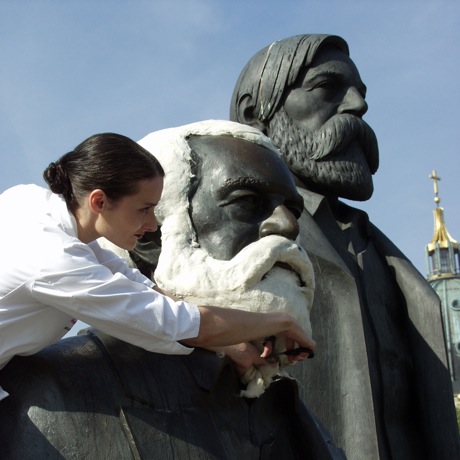“The chronotope is where the knots of narrative are tied and untied… Time becomes, in effect, palpable and visible; the chronotope makes narrative events concrete, makes them take on flesh, causes blood to flow in their veins… Thus the chronotope, functioning as the primary means for materialising time in space, emerges as a centre for concretising representation”[1]
Thus did Mikhail Bakhtin point us towards the crucial juncture wherein time and space combine in the flow of literary form, a concept which has become essential to dramatic theory and the practice of theatre. The playing out of a narrative sequence through performance creates an analogous distillation of the moment. The act of framing such instances for the video camera, of selection, recording, editing and playback, further defines and enhances them.

Elke Reinhuber’s »Perrückt« follows an intervention in public space. Using raw wool, she performs the détournment of a significant historical landmark in former East Berlin: a Socialist Realist statue of Marx and Engels. A lampooning of both official art and the political symbolism of the former GDR, there is also tenderness as the artist stated “I just wanted to give him a nice white beard and hair.”[2] While engaged in ‘feminising’ the stern likeness of Karl Marx, the artist, dressed like an art restorer-cum-hairdresser, even has ready-made postcards of the event for the assembled tourists forming the audience. Reinhuber re-activates an over-familiar image/site, altering perceptions and questioning assumptions about public statues and their meaning in a world of global tourism and hyper-capitalism.
Enacting a performance in public space leads to interactions with diverse audiences, people who bring to the event a variety of experiences, attitudes, and levels of understanding. A tourist from China will experience a very different relationship to Reinhuber‘s work than a visitor from Western Europe. The modification of this particular monument takes on another significance altogether for former citizens of the GDR. Thus »Perrückt« operates as a node within an interrelated network of observed fragments of time/space, grasping the viewer’s attention to reveal a sequence of possibilities.
The artist takes the audience on different journeys: for some, the importance of ritual, of playing a role, is paramount; others choose to focus upon the specific physical, geographical, social or critical contexts for the work. What Reinhuber makes evident is the importance of situation in determining the nature of the artwork: the specific parameters, which dictate the point at which latent potential is transformed into visible action.
Chris Byrne
1 - Mikhail Bakhtin, ‘Forms of Time and of the Chronotope in the Novel: Notes Towards a Historical Poetics’, in The Dialogic Imagination: Four Essays, ed. Michael Holquist, trans. Caryl Emerson & Michael Holquist (Austin: University of Texas Press, 1981)
2 - Cited in a public talk by the artist, Dundee Contemporary Arts, 16 February 2005, (from the author’s own notes.)